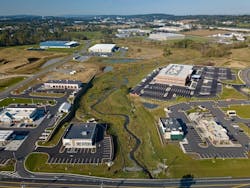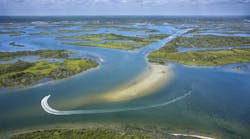About the author:
Len Bradley, P.E., CSI, is supervisor of engineering and associate of RGS Associates Inc. Bradley can be reached at [email protected] or 717.715.1396.
During the early planning stages of a project, developers often question how much of their parcel needs to be designated for storm water management. This concern is understandable given the complexity of local, state and federal storm water management requirements. Storm water management designs, approvals, and permitting often are drivers of the overall profitability of a project, as well as the timing of construction.
Traditional surface storm water facilities reduce the project’s developable area, and underground storm water facilities often inflate project infrastructure costs. Add to those concerns an existing stream and a 100-year floodplain traversing your development’s parcel and the project impacts can be severe. Many engineers, land planners and developers instinctively assume that the floodplain area within their project site is worthless from a development standpoint; however, an innovative ecological approach to storm water management and regional water quality is quickly changing those perceptions.
Floodplain Restoration
Floodplain restoration provides an alternative to traditional best management practices (BMP). It not only mitigates the development’s direct impacts, but also manages and treats the tributary water providing a regional benefit to the overall watershed.
Floodplain restoration as a storm water BMP removes these sediment depositions, reconfigures the stream channel to connect to the historical gravel layer, reshapes the floodplain to allow for frequent inundation, and reestablishes riparian vegetation. The combination of these improvements provides watershed-level denitrification, peak rate reduction, and water quality benefits, as well as project-level volume controls.
The benefits of utilizing floodplain restoration as the primary BMP for commercial, industrial, and residential developments cannot be overstated. By virtue of its function and purpose, floodplain restoration enables the project to utilize the floodplain area in a storm water capacity. While the primary goal is restoration, the secondary benefit is that storm water management requirements for a development project can be met within a previously unused portion of a site. Areas of the project site that traditionally would be reserved for storm water management facilities can be utilized. This increased development footprint provides for greater long-term financial potential for the project.
Beyond the developer’s economic incentive, floodplain restoration projects also can provide public benefits without tax payer monies. Municipalities are burdened with their obligations under the Municipal Separate Storm Sewer System (MS4) permit. This federal mandate for communities of certain populations, along with U.S. EPA pollution reduction requirements for certain watersheds, requires quantifiable pollutant reductions. Meeting these requirements often results in large expensive projects for the municipalities. Floodplain restoration projects can, if adequately sized and positioned within the watershed, meet these obligations without depleting municipal reserve funds.
Additionally, state agencies under similar EPA mandates and consent decrees have documented these storm water credits for federal compliance and planning. These benefits create project partners and advocates, as well as positive marketing collateral for the developer.
Development Opportunities
A project in Lancaster County, Pa., is a 98-acre, multi-phased, mixed-use development that benefitted from floodplain restoration. This project is a public-private partnership between the township and the developer, which meets regulatory requirements and Chesapeake Bay watershed goals.
The development features 25 retail, commercial, warehousing and medical office uses surrounding the 11.5 acres of restored floodplain. With a construction budget of $125 million, the 642,000 sq ft mixed-use project balances economic development with ecological benefits for the community.
Offering a different approach to post-construction storm water management, a floodplain restoration was implemented as the primary BMP in lieu of conventional infiltration or detention facilities to meet the regulatory requirements. This approach includes the removal of sediment to reconnect the stream channel with the floodplain, the creation of large areas of interconnected wetland habitats, and the rehabilitation of groundwater interchange.
The benefits of a floodplain restoration include peak runoff rate reduction, enhanced groundwater recharge, suspended sediment reduction, and nitrogen and phosphorus load reductions, as well as significant ecological and aesthetic improvements.
Construction of 4,750 ln ft of stream channel restoration began in the spring of 2017 and was substantially completed in late fall of 2017. Beyond the inherent habitat and thermal improvements, the project removed 38,500 tons of legacy sediment, created 8.5 acres of additional wetlands, and provides pollutant reductions of approximately 5,773 lb per year of nitrogen, 254 lb per year of phosphorous, and 400 tons per year of sediment. These yearly load reductions meet the township’s obligations for their MS4 permit without the use of tax payer monies.
From an economic standpoint, the utilization of the floodplain restoration resulted in an additional 8.5 acres of developable area. In general terms, the regional value of an improved acre in this zoning district is approximately $225,000; a gross value created of nearly $1.9 million. Reaching the project’s development goals required a regional approach to storm water management and collaboration with federal, state and local permitting agencies. This project embodies the strategy of forming public-private partnerships to meet long-term storm water management goals within the Chesapeake Bay watershed, as well has how floodplain restoration can benefit mixed-use commercial developments.
Necessary Changes
For many regulators and municipalities, alternate approaches to storm water management are an uneasy proposition. Regardless of their prior documented successes, a change from the common practices necessitates a great deal of education for the successful approval and implementation of a floodplain restoration. This education needs to be provided to not only the regulators, but to the developers themselves, along with the general public.
It becomes a major role for the project’s professionals to be facilitators of this education. Once the general public and regulators fully understand the reasoning and benefits of why floodplain restoration is the best choice for the watershed, a developer will likely see these newly created proponents advocating for the project during the approval and permitting phase.
Floodplain restoration is not a viable option for every project or all watersheds. A large amount of watershed-level assessments and field evaluations are necessary to determine the viability of such a project. This is where regulators, planners and community-based watershed alliance members can take an active role in facilitating these changes. The identification of viable stream reaches and their potential watershed benefits are key factors in successful planning. Once these stream corridors are identified, it becomes incumbent on whatever regional planning entity that exists to reevaluate the zoning and development potential of the parcels adjacent to or encompassing the floodplains. In order to incentivize private developers to fund these regional beneficial projects, increased zonings densities may need to be explored.
While many licensed professionals are qualified for the design and permitting of traditional storm water management practices, it is recommended that a qualifications-based selection of licensed professionals be utilized for the size, scale and complexity of projects of this nature. Being an environmental steward and a client advocate are not competing interests, but rather an opportunity for licensed professionals to develop creative storm water approaches like floodplain restoration.


